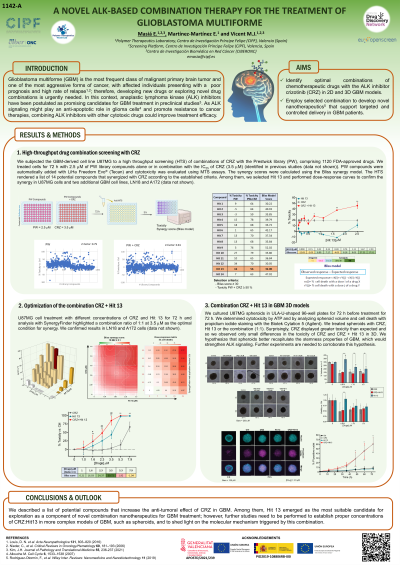Screening Applications & Diagnostics
Poster Session A
(1142-A) Novel alk-based combination therapy for the treatment of glioblastoma multiforme
Tuesday, May 28, 2024
16:30 - 17:15 CEST
Location: Exhibit Hall


Esther Masia Sanchis (she/her/hers)
Technitian head of Screening Platform
Centro de investigacion Principe Felipe CIPF
Valencia, Comunidad Valenciana, Spain
Poster Presenter(s)
Abstract: Glioblastoma multiforme (GBM) is the most frequent class of malignant primary brain tumors and among the most aggressive forms of cancer. Affected individuals present poor prognoses; the standard treatment has not evolved significantly in recent decades; and, most GBM patients relapse after a few months1,2; therefore, we require novel drugs or the identification of novel drug combinations. In preclinical studies, anaplastic lymphoma kinase (ALK) inhibitors have been postulated as promising candidates for GBM treatment; however, clinical trials with ALK inhibitors failed to report significantly improved patient survival rates3. As ALK signaling might play an anti-apoptotic role in glioma cells4 and promote resistance to cancer therapies, combining ALK inhibitors with other cytotoxic drugs may improve efficacy.
This project aims to identify optimal combinations of drugs with the ALK-inhibitor crizotinib (CRZ) in 2D and 3D GBM models with the goal of developing novel nanotherapeutics5 that support the targeted and controlled delivery of an efficacious drug combination to patients.
To this end, we performed a high-throughput-combination-screening of CRZ with Prestwick-library in U87MG cell. We treated cells 72h at 2.5µM at the massive screening stage alone or combined with the CRZ (3.5µM-IC25). We calculated Synergy scores using the Bliss model and set the cut-off for positive hits at a Bliss score of ≥30 and a drug combination cytotoxicity of ≥50% (compared to non-treated). The analysis rendered a list of fourteen potential hits; however, the confirmation of candidates highlighted “Hit 13” as providing optimal synergism with CRZ. Combining different concentrations of both drugs and using the SynergyFinder web-application, we identified an optimal CRZ:Hit13 ratio for enhanced synergism. We selected the 1:1 ratio at 3.5µM for the following assays and we evaluate the anti-tumor potential in a more complex in vitro model. We cultured U87MG spheroids in ULA-U-shaped 96-well plates for 72h before treatment for 72h. We determined cytotoxicity by ATP measurement and by analyzing spheroid volume and cell death with propidium iodide staining with the Biotek Cytation 5. We discovered that CRZ alone exerted a more potent cytotoxic effect in U87MG-spheroids than monolayer cultures, allowing us to decrease the concentration of the drugs needed to exert potent anti-tumor effects.
In conclusion, we describe a list of candidate that increase the anti-tumor effect of CRZ in GBM and report a database of FDA-approved drugs that could be evaluated as potential therapeutic agents for this disease. “Hit 13” synergizes with CRZ and represents the most suitable candidate; this drug will be explored to develop novel combination nanotherapeutics for GBM treatment to increase the effectiveness of the combination therapy. Of note, further studies must establish more adequate concentrations of CRZ:Hit13 in complex models of GBM and shed light on the molecular mechanism.
1.Louis, D. N. Acta Neuropathologica_2016
2.Nieder, C. Critical Reviews in Oncology/Hematology_2006
3.Kim, J.H. Journal of Pathology and Translational Medicine_2021
4.Allouche M. Cell Cycle_2007
5.Rodriguez-Otormin, F. Wiley Inter. Reviews: Nanomedicine and Nanobiotechnology_2019
This project aims to identify optimal combinations of drugs with the ALK-inhibitor crizotinib (CRZ) in 2D and 3D GBM models with the goal of developing novel nanotherapeutics5 that support the targeted and controlled delivery of an efficacious drug combination to patients.
To this end, we performed a high-throughput-combination-screening of CRZ with Prestwick-library in U87MG cell. We treated cells 72h at 2.5µM at the massive screening stage alone or combined with the CRZ (3.5µM-IC25). We calculated Synergy scores using the Bliss model and set the cut-off for positive hits at a Bliss score of ≥30 and a drug combination cytotoxicity of ≥50% (compared to non-treated). The analysis rendered a list of fourteen potential hits; however, the confirmation of candidates highlighted “Hit 13” as providing optimal synergism with CRZ. Combining different concentrations of both drugs and using the SynergyFinder web-application, we identified an optimal CRZ:Hit13 ratio for enhanced synergism. We selected the 1:1 ratio at 3.5µM for the following assays and we evaluate the anti-tumor potential in a more complex in vitro model. We cultured U87MG spheroids in ULA-U-shaped 96-well plates for 72h before treatment for 72h. We determined cytotoxicity by ATP measurement and by analyzing spheroid volume and cell death with propidium iodide staining with the Biotek Cytation 5. We discovered that CRZ alone exerted a more potent cytotoxic effect in U87MG-spheroids than monolayer cultures, allowing us to decrease the concentration of the drugs needed to exert potent anti-tumor effects.
In conclusion, we describe a list of candidate that increase the anti-tumor effect of CRZ in GBM and report a database of FDA-approved drugs that could be evaluated as potential therapeutic agents for this disease. “Hit 13” synergizes with CRZ and represents the most suitable candidate; this drug will be explored to develop novel combination nanotherapeutics for GBM treatment to increase the effectiveness of the combination therapy. Of note, further studies must establish more adequate concentrations of CRZ:Hit13 in complex models of GBM and shed light on the molecular mechanism.
1.Louis, D. N. Acta Neuropathologica_2016
2.Nieder, C. Critical Reviews in Oncology/Hematology_2006
3.Kim, J.H. Journal of Pathology and Translational Medicine_2021
4.Allouche M. Cell Cycle_2007
5.Rodriguez-Otormin, F. Wiley Inter. Reviews: Nanomedicine and Nanobiotechnology_2019
